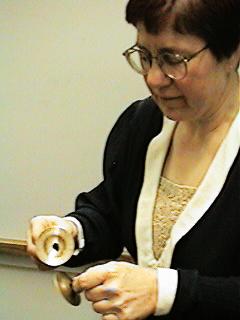







 |
Percussion |
Misc. Percussion
 |
Other Names: Drums (tambour, Trommel, tamburo, tambor, drome, dromme, drume); rommelpost drum; tambourine; finger cymbals | ||
 |
Type: Percussion | ||
 |
Origin: N/A | ||
 |
In Redwall: Drums used by just about anybeast; tambourines, finger cymbals, and rommelpost drums used more rarely, if ever. | ||
 |
Appearance: The traditional drum was a wooden shell covered by some sort of animal skin and was played with sticks, hands, or both. The rommelpost drum is a small, hand-held drum with a slender wooden rod attached to the center of the head inside the drum shell. The tambourine was very similar, if not exactly the same, as today's tambourine- a largish drum with a 2 or 3-inch tall shell through which chimes have been placed. Finger cymbals are tiny cymbals, two or three inches in diameter. | ||
 |
Use: Drums were used in chamber music and for accompanying songs as well as in dance and processional music. The rommelpost drum was played by sliding the fingers up and down on the rosin-covered rod within the shell, making sounds amplified by the drum head. The tambourine is pictured in early art in funeral lamentations, in joyous processions and feasts, and in the hands of angels as well as rustics. It was popular throughout the Middle Ages in all parts of Europe. The tambourine was played by being shaken and/or struck against the heel of the hand or the thigh. Finger cymbals were played in pairs, sometimes one in each hand as pictured, and often in one hand, one held on the thumb and the other on either the index or middle finger. They were used to accompany dances, and sometimes held by the dancers themselves. Finger cymbals are still used in some Islamic countries. | ||
 |
Listen to a drum accompanying some sort of woodwind | ||
 |
For More Information:
|


A Rommelpost Drum Finger Cymbals